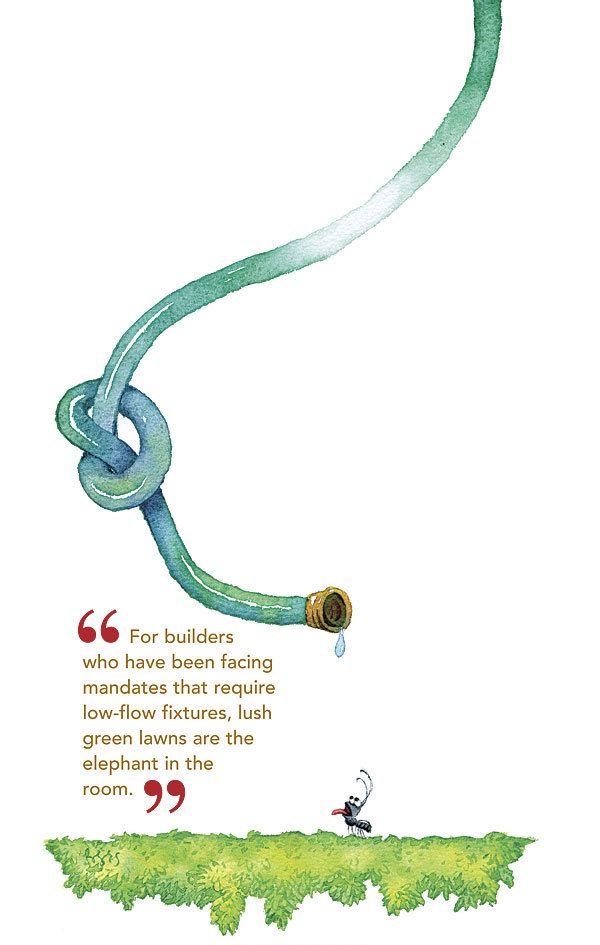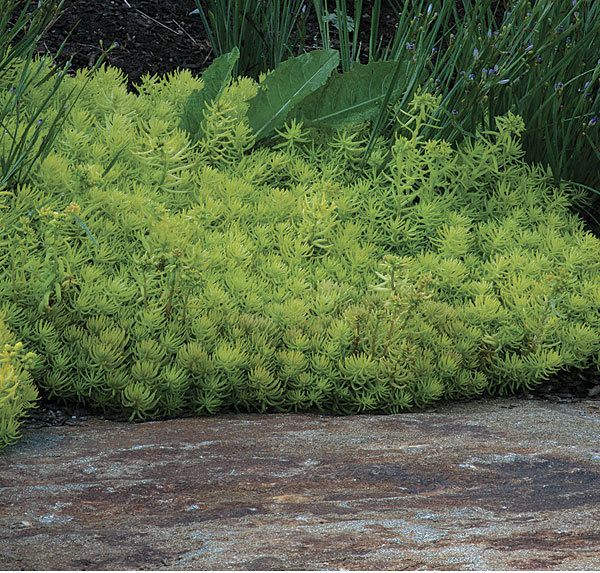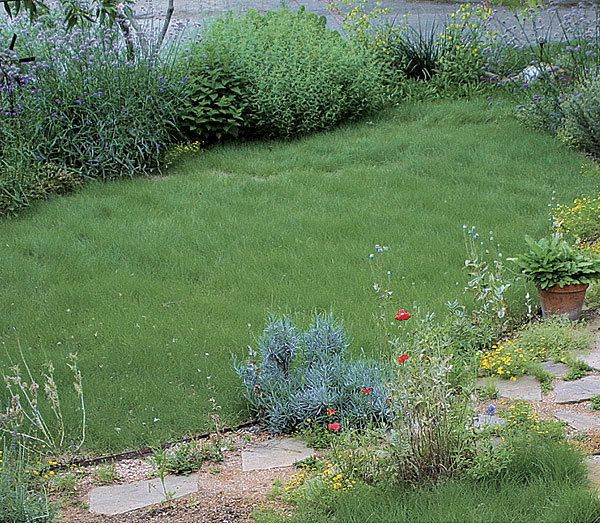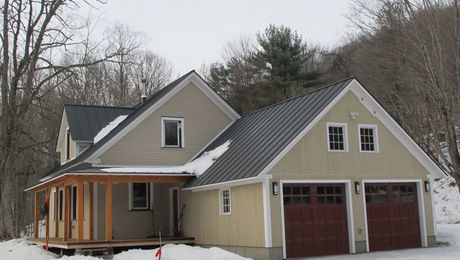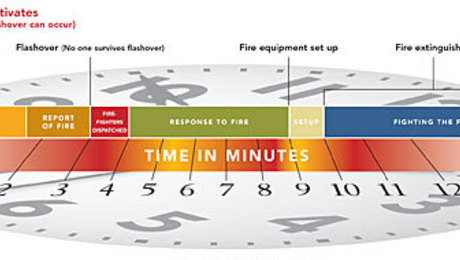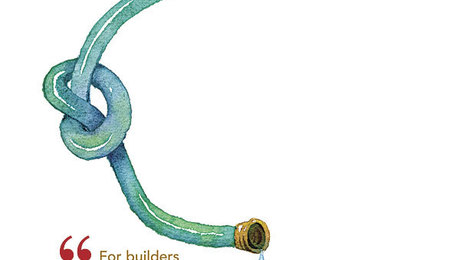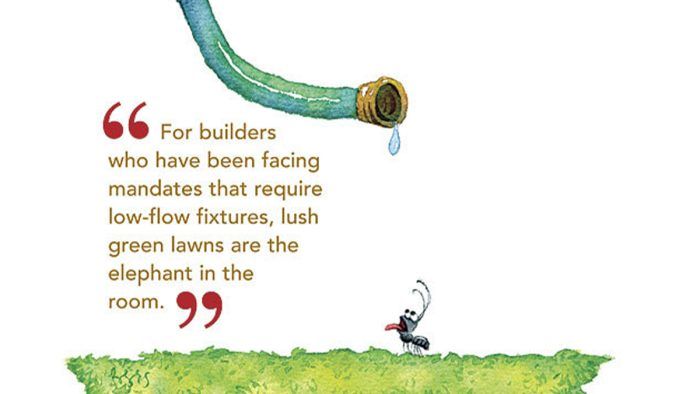
by Susan Harris
from FineHomebuilding #215, p. 10-14
I’m a stranger to the homebuilding world, but it’s nice to see you folks paying so much attention to important issues like water conservation. Low-flow fixtures and water-efficient appliances are a good start. From my world—the gardening world—comes the news that our landscapes are soaking up between 30% and 60% of all residential water. And much of that water is being used to keep lawns green all year long. Water use is just one reason why we need to rethink the Great American Lawn. But for architects, builders, plumbers, and homeowners who have long been facing mandates that require low-flow toilets, showerheads, and faucets, lush, green lawns are the elephant in the room.
Water is scarce, everywhere
We all know that planting a lawn makes absolutely no sense in the arid Western United States. The good news is that this out-of-place aesthetic is changing and that xeriscaping is taking over as the landscaping trend in much of the country. Like many things, the change is being forced by the almighty dollar in the way of both penalties and incentives.
Water authorities in Tucson, Ariz., for example, have switched to conservation pricing, which means that the more water you consume, the more you pay per gallon. Albuquerque, N.M., gives rebates to homeowners who xeriscape their property. And Las Vegas pays residents $1.50 for every square foot of lawn they rip up.
What these municipalities know is that keeping your lawn lush consumes more than just a lot of water; it consumes a lot of energy. In California, for example, 20% of electricity consumed is used to pump water, according to a 2004 National Resources Defense Council report. California law now prevents homeowner associations from requiring watering.
Even in the East, where rainy spring months can make it feel like water is in abundance, there is cause for concern. Significant droughts in recent years coupled with population growth have led to water wars between neighboring states, as in Georgia, Alabama, and Florida. At various times, Georgia has resorted to water restrictions that prohibit outdoor watering altogether and also has switched to conservation pricing.
There are other, less obvious environmental impacts of our ever-green, weed-free lawns. One is water pollution.
The toxic playground
Fertilizer-laden rain runoff ends up in our waterways and results in large dead zones where fish and aquatic plants can no longer survive. While the primary culprit here is agriculture, lawns contribute to the problem, and lawns are something homeowners can change.
Turf grasses need supplemental nitrogen to stay healthy, but not the tons of fast-acting fossil-fuel-based chemicals that fertilizer companies tell us to apply in multiple steps throughout the year. Just one application of compost or plant-based fertilizer every fall will do the trick without the same environmental consequences.
We should be alarmed by the skull-and-crossbones signs that signal commercially treated lawns. According to the Audubon Society, 78 million pounds of pesticides are dumped on lawns every year. These chemicals are not only polluting our rivers, lakes, and oceans, but they’re also toxic to our children, who consider a green lawn a playground. (Find out more about lawn problems and solutions at BeyondPesticides.org.) And it doesn’t stop there. For almost every lawn, there is an inefficient, gas-powered mower polluting the air.
Fortunately, changes are coming on these fronts, too. Pesticides for ornamental purposes are now banned in most of Canada. Connecticut has banned them from schoolyards. New York restricts pollutants in lawn fertilizers.
Alternatives abound
I can accept that most families need some lawn. There’s no better ground cover for kids, pets, and sports of all types. So by all means, keep the lawn you actually use. But ask your landscaper to plant a variety that makes sense in your area, one that needs little water, like buffalo grass and fine fescues. Also, consider a little biodiversity in your lawn, and by biodiversity, I mean weeds. Giving up weed killers saves you money while helping our threatened pollinators. Clover can be a wonderful asset to your lawn. It feeds pollinators, fixes nitrogen, and requires little water.
Where you don’t need lawn, consider some of the alternatives. Madison, Wis., recently overturned laws outlawing prairies. And my own county in Maryland now allows homeowners to grow meadows that need mowing only once a year.
You can plant a small grove of trees or do like I did and replace your lawn with a creeping succulent called sedum that stays only 4 in. tall, never needs irrigation or fertilizer, can handle some foot traffic, and even looks nice in the winter. In the first year, I had to do some serious weeding, but by the second year, the sedum filled out nicely and now prevents new weeds from germinating. Sedums are the mainstay of green roofs, so it’s no surprise that they’re the closest to no-maintenance as any sun plant can possibly be.
Another option is to turn your lawn space into a garden with a variety of shrubs, perennials, and annuals. This is not a low-maintenance option, but you may find that you like getting your hands dirty.
If you really want to make the most of your yard, consider planting a vegetable garden. High-profile residents at the White House and governors’ mansions across the country are trading in some of their lawn for the most useful plants of all: the plants that feed us.
Fine Homebuilding Recommended Products
Fine Homebuilding receives a commission for items purchased through links on this site, including Amazon Associates and other affiliate advertising programs.

Affordable IR Camera

Reliable Crimp Connectors

8067 All-Weather Flashing Tape
